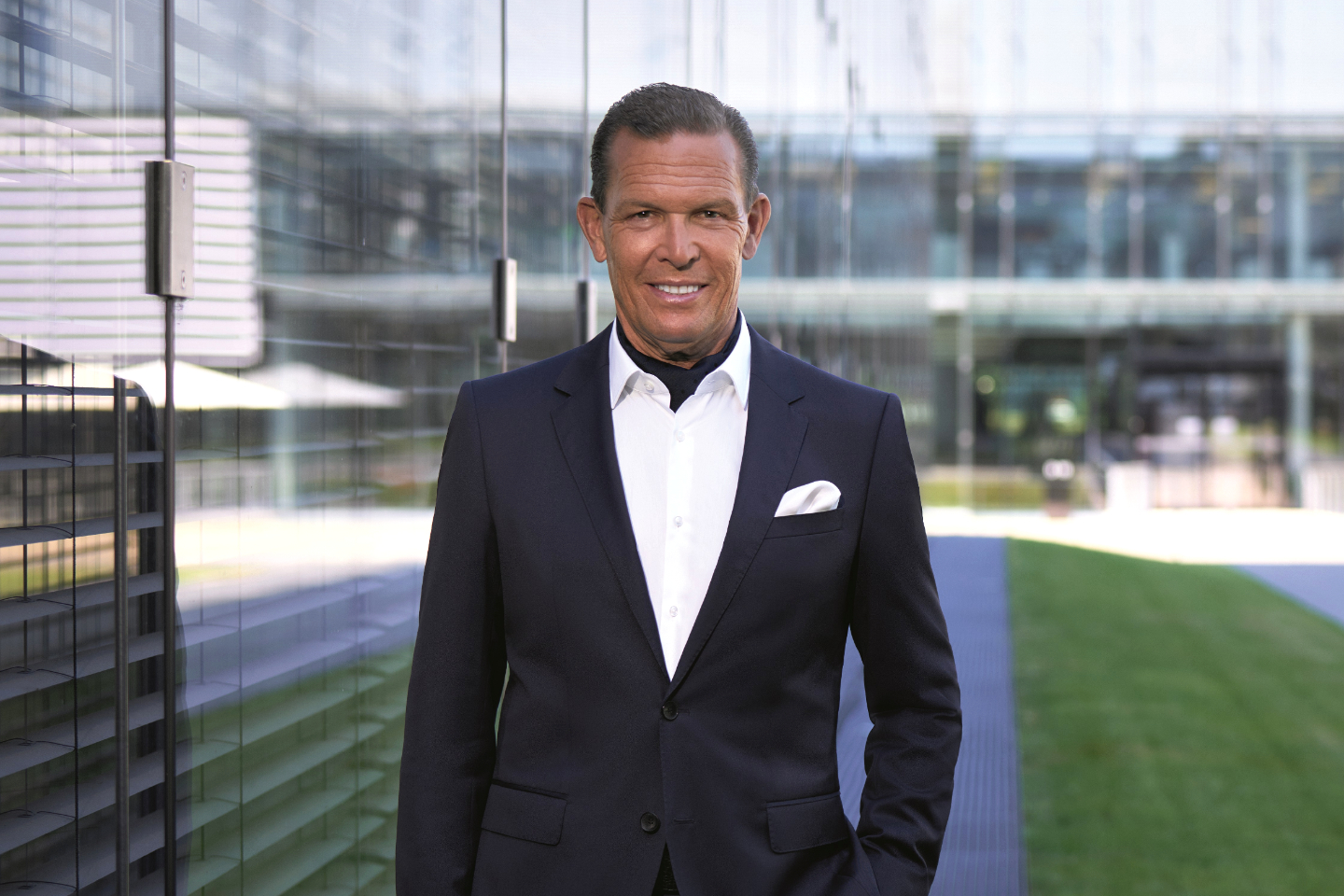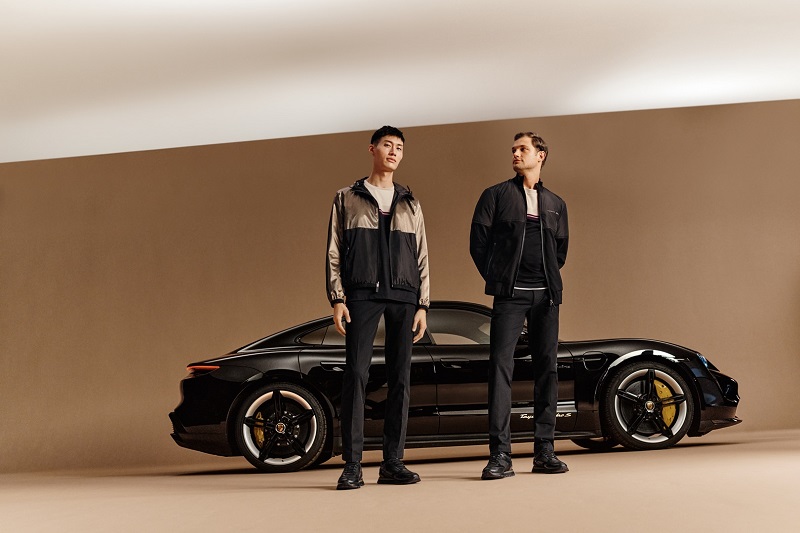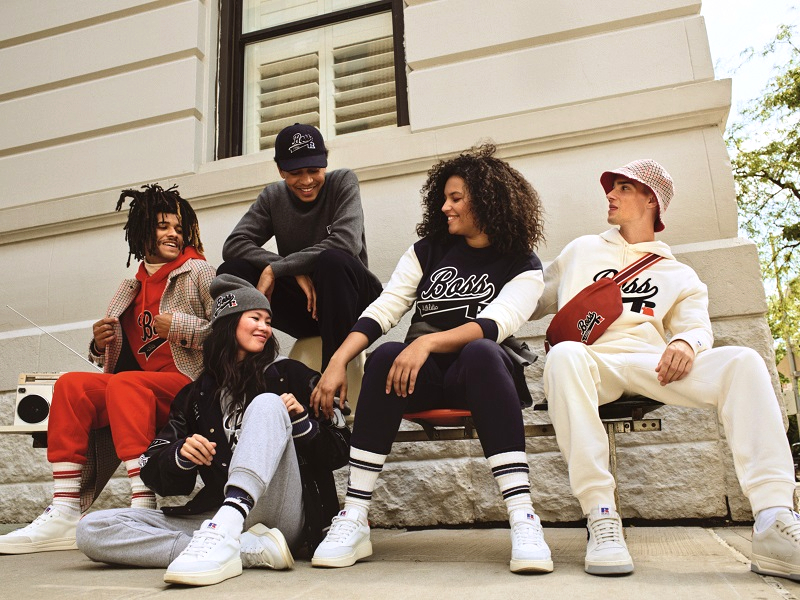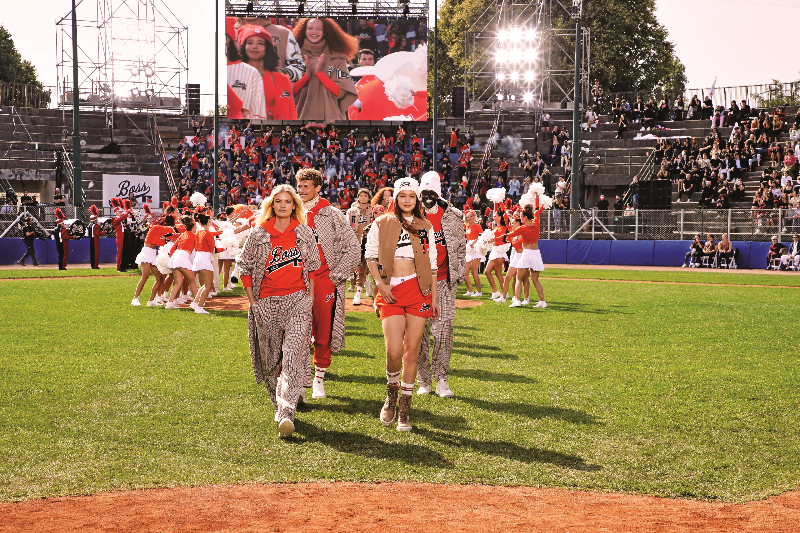
Grieder aims for Hugo Boss to top the €4 billion mark in sales by the end of the 2025 financial year (All photos: Hugo Boss)
Oh, to have been a fly on the wall during Hugo Boss CEO Daniel Grieder’s first strategy address in August. We do not have too many details, but there was talk of an Olympics analogy (like athletes, the German fashion brand is sure to re-establish its supremacy after a less-than-desirable run), a five-pillar plan to implement Grieder’s ambitious growth strategy, as well as who had dibs to his painstakingly acquired Tommy Hilfiger wardrobe since he would have had to give up his casual gear for Hugo Boss’ more tailored choices after leaving the American leisurewear brand to run the celebrated suiting company.
“I have opened up my wardrobe, which is full of Tommy Hilfiger items, to my sons and friends. For myself, I now have a complete Hugo Boss wardrobe,” he said smilingly during his online press conference. “The suit, combined with a white shirt and a pocket square or, for a more casual look, a polo shirt, completed with high-profile sneakers — that’s my personal style.”
Appreciative as we are of his style advice, Grieder’s most notable reveal during his digital presentation was less sartorial, and more financial — he aims for Hugo Boss to top the €4 billion mark in sales by the end of the 2025 financial year.
The man has set himself up for quite a challenge. The fashion group’s sales fell below the €2 billion threshold in 2020, with operating income plunging €236 million. This trend is unfortunately not unique to Hugo Boss, as many luxury apparel retailers suffered quite a blow at the hands of the pandemic. With many working from home, suits were hardly a priority purchase. However, now that things are gradually opening up — in Asia, things definitely look more encouraging than in Europe — and suiting styles would have changed, it is safe to say things are looking up.
hugo_boss_x_porche.jpg

Founded in 1924 by entrepreneur Hugo Boss, who most audaciously named the business after himself, the company started out producing general purpose clothing and, later on, uniforms for the German wartime government. Post-WW2, Hugo Boss shifted its focus to men’s suits and, in the 1970s, the founder’s grandchildren Uwe and Jochen Holy took things up a notch — the company was one of the first major menswear manufacturers in Germany to modernise its production facilities and harness the power of massive advertising campaigns. The brothers also began making more youthful, fashion-conscious, dark and slick suiting from lighter fabrics. This was no more a mere run-of the-mill suiting brand, but a fashion label with an identity.
Hugo Boss ceased to be in the hands of its founding family in the 1980s but most notably, had no bearing on the way the company continued to grow. Mens- and womenswear diffusion lines were added in 1997 and a children’s collection in 2006. It rapidly expanded its accessories business, launching fragrance and eyewear divisions in the 1980s. In 1995, it added footwear, which was the start of what is now a fully developed leather goods range across the company.
In its journey from clothing manufacturer to major global fashion house — Germany’s largest — Hugo Boss today owns more than 443 retail stores worldwide. Its smartly cut suits and premium fabrics are beautifully made, aesthetically pleasing and have managed to keep the company far ahead enough of contemporary trends to remain successful. The brand was also accessible from a stylistic and affordability standpoint, which allowed more men — especially from a younger generation — to consider the idea of wearing a suit that worked for them, instead of relying on what their fathers or grandfathers may have considered stylish at the time. Hugo Boss’ pedigree has served it well — it has emerged as a dynamic and youthful label that is able to find common ground between proper, old-fashioned standards of tailoring and a very fashion-forward sense of style.
Hugo Boss’ collaborations over the years did much to raise its public profile and give it solid street cred. They include partnerships in sports such as sailing, football and Formula E racing; altruism-driven ones with Unicef and Save the Children; and creative unions with New York’s Parsons School of Design, Porsche and, most recently, Russell Athletic. While it may not seem like Hugo Boss and the latter, an American sportswear brand founded in Alabama in the early 1900s, have much in common, Grieder assures us that there will be more of such unexpected partnerships to come.
bossxrussellathletic_embargosept23_011_srgb.jpg

“Unexpected collaborations are an important part of our new growth strategy, as they enable us to realise the full potential of our brands,” he says. “Our goal is to inspire and excite existing and new customers alike and to offer 24/7 lifestyle outfits to dress consumers throughout the day, for every occasion. The various casual collaborations we do absolutely play into this and strengthen the brand’s position in the crucial growth area of casualwear, also among younger consumers. We are known as a suit brand and this is our DNA. But, today, we are much more than this and successfully offer a wide range of casualwear in our regular collection. Therefore, the Boss x Russell Athletic capsule collection is only one, but a very good example of this.”
It would seem that success was a given for Hugo Boss, but the changing face of retail cast a spanner in the works, and the pandemic did them no favours either. But it is unfair to blame the retail misfortunes suffered by Hugo Boss and other fashion retail brands entirely on Covid-19 — even prior to the pandemic, the call for change was loud and clear from consumers who were searching for unique products and novel shopping experiences. Upon arriving at Hugo Boss’ headquarters in Metzingen, Germany, in June last year, Grieder studied the brand, its unique challenges and strengths, and what its next steps would be.
Claim 5 is his thoughtfully crafted answer to this — as the name suggests, he aims to reclaim Hugo Boss’ position of dominance in the industry. The five pillars of this overarching strategy are to boost brands in the group, champion the strength of its products, take the lead in digitalisation, rebalance their omnichannel offerings and organise the company for future growth.
“It really gets to the heart of the matter,” Grieder remarks. “For example, we will focus on boosting our brands in the years to come by increasing brand relevance for Boss and Hugo, especially among younger consumers. In addition, digitalising our business and driving the use of data will play an important role, and I will, of course, add my personal expertise and experience to this.”
He has help, too. “I want to highlight that we have a great team in place at Hugo Boss, with excellent knowledge and a great mindset. I absolutely enjoy working in this environment. We have set ourselves the target of becoming the premium tech-driven fashion platform worldwide, and one of the top 100 global brands. This is what we will focus on together.”
Unexpectedly, a major aspect of Claim 5 is a clear strategy for digitalisation — something all retailers have had to come to terms with. Although the lockdowns might have hastened this move, it was a major point of consideration in recent years. It is correct to say that a younger generation of consumers has been pushing for this, alongside other important elements that no retailer can afford to ignore these days: a more inclusive approach to sartorial style and a stronger focus on sustainable fashion.
In fact, if last year was about dealing with the shocking effects of the pandemic, this year is geared towards re-evaluating business practices, reinvention and innovation. “The pandemic has accelerated many developments in recent years, such as digitalisation, especially e-commerce, but also the trend towards casualisation in fashion,” Grieder agrees. “Many companies had to take a hard look at their strengths and weaknesses, and this has triggered a surge in innovation within the industry. This offers new opportunities for the future. Our consumer touchpoints, for example, will be more connected than ever before to offer a seamless shopping experience — online and offline. Our points of sale will be turned into points of experience as we integrate new services and offers to add value for the customer.
“Sustainability has also become more of a focus for many people, even in terms of their expectations of fashion. This is a valid point, because if there is no planet, then there is no fashion. So, brands must meet such expectations if they want to be relevant to consumers in the future.”
While it is correct to say that global economic and political realities, along with changing luxury consumer demands, are forcing retailers to think about what they sell and how, a new generation of buyers is driving change most emphatically. Luxury sales growth is now being propelled by millennials and Gen Z, meaning these groups must now be catered to with more personalised experiences that blend offline and online offerings — via means that include “voice commerce” conducted through the Internet of Things, augmented reality and artificial intelligence.
That brings us back to Hugo Boss’ own efforts in this regard, and how it links to the ambitious revenue targets Grieder has set for the company. “Our ambition is to double our worldwide business to €4 billion in group sales by 2025. Therefore, more than one billion will come in through digital sales. The digital channel is therefore one of the key growth drivers, but our aim is to accelerate growth across all brands, touchpoints and regions. Today, the customer journey starts online and, therefore, we will elevate our digital brand environment.
“We will, for example, refresh of our digital flagship-store, hugoboss.com, and complete the global rollout. In 2020, more than 30 online markets, including Malaysia, were added to the existing 15 countries. And we will further boost the digital partner business in the coming years. Under this growth plan, Asia-Pacific, next to Europe, will continue to be the focus for further extending the online concession model.”
Social media will provide an easily accessed worldwide platform for many of Hugo Boss’ digital activities to unfold, involving fans of the brand no matter where they are. Fans turn into paying customers, Grieder points out, so this aspect is hugely important. “With the social-first approach for our Boss x Russell Athletic launch as part of Milan Fashion Week, we have already created a phenomenal digital buzz worldwide. This event is our benchmark for what we will deliver as a digital experience to customers around the world from today. It underlines the great potential and global brand strength of Boss and plays into our target to turn fans into buyers.”
Grieder knows this to be true from personal experience, but acknowledges that being inspired by the brand at one point in time does not equate to a lifelong love affair. No matter what, Hugo Boss must continue to stay ahead of the curve and engage with customers in meaningful ways that keep them wanting to return. This is a great label with captivating stories and well-made products, but it is important not to take it for granted. A visionary leader, Grieder has big plans for the future of the brand while always taking into account its history and distinct identity.
01_hb_ss22ps_boss_ra_launch_event_finale.jpg

“This exciting success story has always fascinated me,” he says. “But what made a brand big in the past will not necessarily guarantee its success in the future. So, we continuously have to reinvent ourselves to stay relevant to the consumer, and I see a lot of potential here for Hugo Boss. We have an exciting time in fashion, and this inspires me to shape the future together with the team.”
Grieder started his career in retail as an entrepreneur in 1985, founding a company that produced and sold leatherwear to leading department stores throughout Switzerland. His next venture was a multi-brand store that carried, among others, the brand with which he would spend the bulk of his career — Tommy Hilfiger. He spent 16 years with the brand as CEO and, when it was acquired by PVH Europe, took on the additional role of CEO of the apparel group. He arrived at Hugo Boss in June this year and, by August, was ready to go live with his turnaround plan for his new employers.
As one might imagine, he has been given a bit of a hero’s welcome at Metzingen — staff have clearly been yearning for a plan for the future that they can get behind. “I had a very good start,” he agrees. “I was given a very warm welcome by the employees at our headquarters, and I already feel part of the Hugo Boss family. And the welcome I received at our subsidiaries around the world, some of which I have visited in recent weeks, was just as warm. Therefore, I am also looking forward to travelling to Asia and meeting more colleagues here soon.”
Grieder has carefully crafted a schedule that allows him to be at work in Metzinger and spend time with his two sons in Zurich, Switzerland, which is fortunately not very far away. With rising Covid-19 cases in Europe, hopefully border shutdowns will not affect his plans.
But should he be stranded away from Metzinger for any reason, he has left behind a beautifully engineered plan for the team to follow quite closely. A mark of a true leader, one might say, is ensuring that the show will go on even if the maestro is temporarily out of commission. To do this, Grieder goes back to his understanding of Hugo Boss and how it has embraced its past, learnt from its mistakes and kept an eye on the goal: commercial success and reaffirming its forte in innovation and good taste.
“Success and style are the DNA of Hugo Boss and we are also pioneers in fashion. Our strengths include high global brand awareness and a premium lifestyle positioning,” he says, rounding off his chat with Options. “Besides this, we have a diversified business model, strong distribution network and a diverse, motivated team. And our strong financial position and in-house production provide great flexibility in realising our growth story. Last but not the least, we are known as leaders in sustainability. Together, this presents a strong foundation to unlock the full potential of the company in the future.”
This article first appeared on Nov 22, 2021 in The Edge Malaysia.


